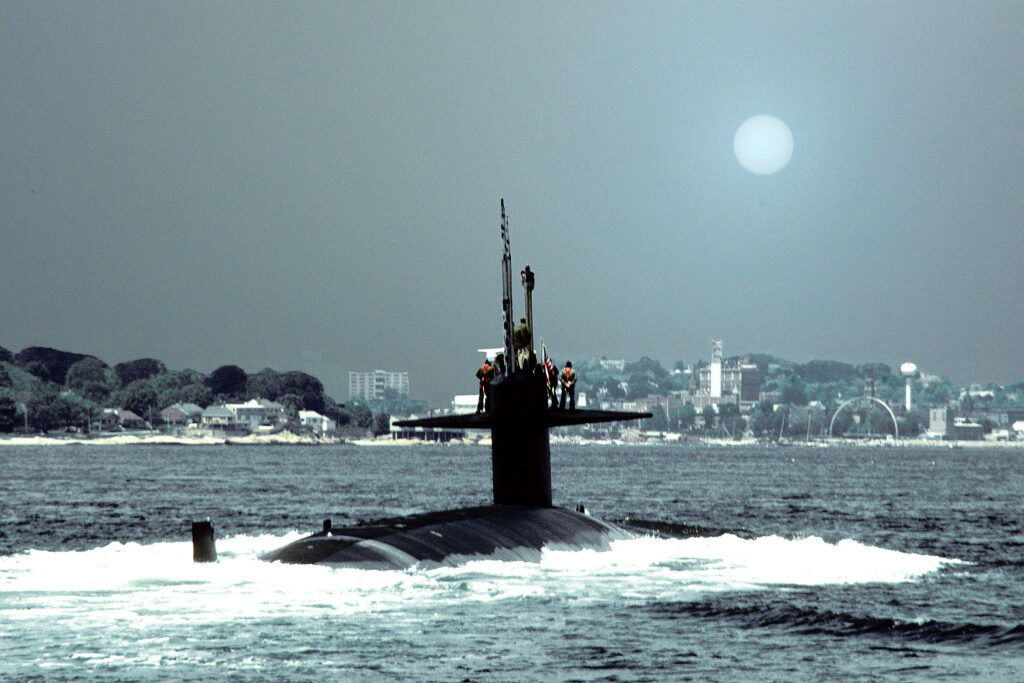First established in April 1868, the site of New London’s Submarine Base first served as a storage depot and a naval yard for laying up inactive ships. Developed in Groton, the 112-acre site was on land donated by the State of Connecticut, situated along the Thames River, just opposite New London.
In 1898, the base was converted into a coaling station for refueling naval ships operating in coastal New England waters. But fourteen years later, as coal was being replaced by oil, the base was scheduled for closure. However, following the stationing of six submarines at the base on October 18, 1915, the site was designated a submarine base. Three of the vessels were G-class submarines; G-1 and G-2 were gasoline powered, while G-3 had diesel engines. Their maximum depth was about 200 feet. Surfaced, they could travel 2,500 nautical miles while attaining a speed of 9 mph. Submerged, they could only journey 70 nautical miles, at 5 mph. The submarines were armed with 8 torpedoes. During WW l, the remaining submarines, D-1 and D-2, were stationed at New London’s base. They served mainly as trainers while E-1 patrolled the waters off the Azores. However, it later returned to New London, where it also operated as a trainer. All three were decommissioned between 1921 and 1922. They were scraped.

After Yeates Stirling took command of the base in 1916, he established a submarine training school. Near the end of that year, 22 had graduated and were then immediately assigned to a submarine for further training. By the 1980s, approximately 60,000 students per year received training at the school.
In April 1917, when the U.S. entered World War 1, many of the trained officers and crewmen were already serving aboard submarines. Later, during the war, New London’s base served 20 submarines with the support of 1,400 men. Most of the submarines were active in patrolling the East Coast, while a few cruised the waters off Ireland as part of the Nation’s commitment to the war. However, perhaps one of the greatest contributions to the war effort was the development of hydrophones by Groton’s researchers. With the listening devices placed in the water, sailors could track submerged enemy submarines. Once located, depth charges were released to destroy German vessels. Hydrophones helped defeat the German submarine force.
In 1930, President Franklin Roosevelt created a federal stimulus program in response to the Great Depression. As part of that program, warehouses, barracks and workshops were built on the base, along with a 119-foot tall submarine escape tower. It would mark the base from the 1930s to 1994. The escape tank was constructed to train personnel with procedures for escaping a sunken or disabled submarine. Entering locks similar to those aboard a submarine, the sailor ascended the tank equipped with a re-breathing device. In 2007, the original escape tank was replaced by a 40-foot high, 20-foot diameter tank with two recompression chambers.
During WW II, submarines played an important role in the Pacific by cutting Japanese supply lines. They succeeded in destroying 1,392 enemy vessels. During that same period, New London’s subbase increased its size from 112 acres to 497 acres to accommodate many new buildings, docks and other facilities. From 1941 to 1945, Electric Boat produced 74 submarines, some of which were stationed at New London. As part of the growth, the Naval Submarine Medical Laboratory (NSMRL) was established. Its mission included instructing corpsmen and medical officers in submarine medicine. However, an equally important mission included the evaluation of future submariners’ ability to adapt and perform in the confines of a submarine. Using research conducted over many years, NSMRL developed a Psychological Testing Program that is still in use today.
In 1952, work began on the world’s first nuclear submarine at Groton, Connecticut’s Electric Boat Shipyard. On September 30, 1954, Nautilus (SSN-571) was launched as First Lady Mamie Eisenhower broke a bottle of champagne over its bow. Over its career, Nautilus participated in numerous fleet exercises and research, but in 1958, the submarine perhaps made its most famous expedition. Submerging near Point Barrow, the northernmost point in Alaska, Nautilus traveled under the Arctic icecap to reach the North Pole (90 degrees North). It then made its way to the Greenland Sea and Iceland. The submarine had established the shortest route from the Pacific to the Atlantic and Europe. In celebration of the 50th anniversary of Nautilus’ accomplishment, the USS Providence (SSN-719) made its way to the North Pole in 2008.
Commissioned in 1959 at Groton, Connecticut, the nuclear-powered submarine USS George Washington (SSBN-598) was the first in its class designed to serve as an underwater launching platform for Polaris missiles. Stationed at the New London base, the submarine steamed for Cape Canaveral, Florida, on June 21, 1960, loaded with two Polaris missiles. A month later, the submerged submarine successfully launched the test missiles. It was the first time that it had ever been done.
Following the successful launches, the submarine patrolled the Atlantic, including the Soviet coast, for over 4 years. During that time, it steamed more than 100,000 miles! In 1965, the vessel was transferred to the Pacific Fleet, where it operated for nearly 20 years. Decommissioned in 1985, the submarine was scrapped. However, its conning tower was saved and later placed on display at Groton’s Submarine Force Museum. The museum is also home to the first nuclear submarine, Nautilus (SSN-571). Open to the public, a walk through the submarine is a great experience for anyone interested in our naval history. The museum has been described as “an absolute gem worth exploring.” It also has a collection of 33,000 artifacts dating back to the Civil War to modern times, along with thousands of documents and photographs related to the development of submarines.
Known as “The Home of the Submarine Force,” the Naval Submarine Base at New London continues to be a home port for advances in submarine weapons technology. The vessels are a critical part of our Nation’s defense.
